|
|
|
Sort Order |
|
|
|
Items / Page
|
|
|
|
|
|
|
| Srl | Item |
| 1 |
ID:
169716
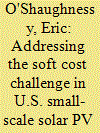

|
|
|
|
|
| Summary/Abstract |
Solar photovoltaic (PV) prices have fallen significantly over the past two decades. These price reductions have relied primarily on falling system hardware costs. Future reductions in PV prices—which are needed to ensure that enough PV will be deployed to meet global clean energy objectives—will require reductions in non-hardware or “soft” costs, particularly in markets with relatively high soft costs such as the United States. In this article, we draw insights from the literature on which factors affect soft costs for small-scale PV systems in the United States. The literature shows that soft costs tend to be lower for systems that are larger, installed during new construction, installed by more experienced installers, installed in more concentrated markets and in more competitive markets, installed in markets where customers receive more quotes, or installed in markets with less onerous permitting requirements. We identify three marketplace design strategies that policymakers could pursue to address the soft cost challenge in the United States and similar markets: encourage the expansion of quote platforms; encourage or require that PV system installation be integrated into the new construction and roof replacement process; and encourage the expansion of customer aggregation models such as Solarize campaigns and community solar.
|
|
|
|
|
|
|
|
|
|
|
|
|
|
|
|
| 2 |
ID:
127934
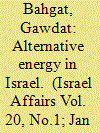

|
|
|
|
|
| Publication |
2014.
|
| Summary/Abstract |
Unlike other countries in the Middle East, Israel has limited hydrocarbon deposits. Since its founding in 1948 Israel has largely relied on foreign supplies to meet almost all its energy needs. In recent years substantial natural gas deposits have been discovered in the Eastern Mediterranean. These discoveries are likely to fundamentally improve the country's energy security. Equally important, Israel has invested massive efforts and resources to utilize the largely untapped solar and wind power. It has also considered initiating a nuclear power programme. Finally, efforts have been made to raise energy efficiency.
|
|
|
|
|
|
|
|
|
|
|
|
|
|
|
|
| 3 |
ID:
099360


|
|
|
|
|
| Publication |
2010.
|
| Summary/Abstract |
This paper provides an assessment of the large-scale implementation of distributed solar photovoltaics in Wisconsin with regard to its interaction with the utility grid, economics of varying levels of high penetration, and displaced emissions. These assessment factors are quantified using simulations with measured hourly solar radiation and weather data from the National Solar Radiation Database as primary inputs. Hourly utility load data for each electric utility in Wisconsin for a complete year were used in combination with the simulated PV output to quantify the impacts of high penetration of distributed PV on the aggregate Wisconsin electric utility load.
As the penetration rate of distributed PV systems increases, both economic and environmental benefits experience diminishing returns. At penetration rates exceeding 15-20% of the aggregate utility load peak, less of the PV-energy is utilized and the contribution of the aggregate electricity generated from PV approaches a practical limit. The limit is not affected by costs, but rather by the time-distribution of available solar radiation and mismatch with the coincidence of aggregate utility electrical loads. The unsubsidized levelized cost of electricity from PV is more than four times greater than the current market price for electricity, based on time-of-use rates, in Wisconsin. At the present time, the investment in solar PV as a cost-effective means to reduce emissions from traditional electricity generation sources is not justified.
|
|
|
|
|
|
|
|
|
|
|
|
|
|
|
|
| 4 |
ID:
090039
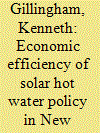

|
|
|
|
|
| Publication |
2009.
|
| Summary/Abstract |
New Zealand has recently followed the path of several other countries in promoting solar hot water (SHW) systems in the effort to reduce greenhouse gas emissions, yet the economic efficiency of large-scale policies to encourage SHW remains a pressing question for policymakers. This paper develops an economic framework to examine policies to promote SHW in New Zealand, including the current information, training, and subsidy policy. The economic framework points to environmental, energy security, and average-cost electricity retail pricing market failures as motivation for SHW policy, with the global climate change externality the most important of these. The results indicate that domestic SHW systems are close to being financially attractive from a consumer perspective, but a more substantial subsidy policy would be necessary for SHW to appeal to a wider audience. Such a policy is far more likely to have positive net benefits than a policy of mandating SHW on all homes or all new homes in New Zealand, and could be justified on economic efficiency grounds under reasonable assumptions. However, this result reverses under an economy-wide carbon trading system that internalizes the environmental externality.
|
|
|
|
|
|
|
|
|
|
|
|
|
|
|
|
| 5 |
ID:
118055


|
|
|
| 6 |
ID:
190602


|
|
|
|
|
| Summary/Abstract |
A major challenge faced by policymakers has been determining appropriate subsidy amounts for household energy investments. This can result in inequitable support being either insufficient or excessive. Equitable reverse auctions offer a novel approach to address these issues. Households can bid an amount as a subsidy from the government that they require to go ahead with an energy investment. The lowest bids are successful in a reverse auction, allowing for cost-effective government support. The novel part is the pursuit of equity, as these auctions can occur separately for a pre-determined number of carefully chosen socio-economic groups. Equitable reverse auctions would lower inequality by design, relative to a common benchmark of equal subsidies, for a given government budget and environmental outcomes. Compared to a standard reverse auction, an equitable reverse auction will have greater equality by design but lower cost-effectiveness. However, the design of equitable reverse auctions is cost-effective within each socio-economic group. Non-additional subsidy spending would be reduced through reverse auctions. Equitable reverse auctions would be flexible to fit circumstances across countries, time, and technologies.
|
|
|
|
|
|
|
|
|
|
|
|
|
|
|
|
| 7 |
ID:
114287
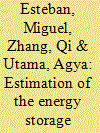

|
|
|
|
|
| Publication |
2012.
|
| Summary/Abstract |
Renewable energy systems are often criticized because of their intermittency and need for substantial amount of backup in terms of other energy sources or storage. The present paper proposes a method to estimate the required amount of storage backup for a mostly solar and wind system that uses also biomass and hydroenergy as minor components of the electricity mix. An hourly simulation was carried out to determine the amount of electricity that could be produced based on the meteorological conditions of year 2001 in Japan, and this was compared with the maximum electricity demands imposed in the system for each month of the year. The system thus proposed has 100% chance of meeting around 40% of the electricity demand between 11:00 and 18:00, and the optimum scenario obtained (a 2:1 mix of solar to wind energy) required around 40 TW of storage to balance the extra electricity demand that occurs during the summer in Japan. It appears unlikely that the batteries in EV in vehicles will be able to meet this storage requirement in the future, though the system is able to adequately meet the electricity demand during the majority of the year, and hence showcases the viability of renewable energy.
|
|
|
|
|
|
|
|
|
|
|
|
|
|
|
|
| 8 |
ID:
188563


|
|
|
|
|
| Summary/Abstract |
Net energy metering (NEM) has become a powerful regulatory tool for promoting distributed generation (DG) worldwide. NEM aids utilities in reducing power constraints and line losses and effect positive economic gains by integrating renewable energy sources. In Pakistan, the current NEM market is limited to three-phase users, even though single-phase customers account for 90% of all residential connections, equal to 28 million, and can significantly impact Pakistan's NEM growth. Therefore, the conducted study provides the techno-economic evaluation of NEM for single-phase consumers. The article offered policy proposals to encourage distribution companies (DISCOs) and single-phase customers to adopt NEM to achieve a win-win situation. The technical analysis is conducted to see how the single-phase NEM affects voltage regulation, system unbalances, and line losses. The viability of the current feed-in tariff for single-phase NEM consumers is assessed to analyze the economic impact. The results show that if only 5% single-phase NEM is allowed, 7.54 TWh can be renewably added to the grid, reducing 4.95 Mtonn CO2 emissions. Furthermore, this paper presents a case study of how the consumer and the DISCOs can benefit from several NEM penetration. The presented analysis and policy recommendations may help Pakistan and other countries with identical socio-demographic profiles.
|
|
|
|
|
|
|
|
|
|
|
|
|
|
|
|
| 9 |
ID:
179682


|
|
|
|
|
| Summary/Abstract |
About 1 in 10 rooftop solar photovoltaic (PV) customers who sign a contract to install a PV system cancel their contract before the system is installed. Although some cancelation risk is inherent in the solar industry, there may be ways to reduce cancelation volume, such as reducing project delays. Delays can occur at each stage of PV adoption processes, which take several weeks to months from contract signature to system operation. Using data from a recent survey of PV installers, we explore the factors that explain PV project delays and cancelations. The survey data suggest that PV adoptions take about 16 weeks, on average, from contract signature until system operation. Survey respondents consistently identified permitting, inspection, and interconnection (PII) processes as key drivers of project delays. Most respondents then suggested these PII-related delays increase contract cancelations. However, larger-scale installers report higher cancelation rates, and these installers rank changes in customer financial situations higher than PII-related delays as the main cause for cancelations. Most respondents also reported avoiding jurisdictions with particularly onerous PII requirements or charging more in these jurisdictions. On balance, the results provide a rationale for measures to streamline PII processes to reduce delays and potentially mitigate cancelation risk.
|
|
|
|
|
|
|
|
|
|
|
|
|
|
|
|
| 10 |
ID:
163562
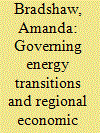

|
|
|
|
|
| Summary/Abstract |
States, regions, and municipalities have a growing importance in innovating policies to promote renewable sources of energy. This article examines the contribution of three state governments in developing and deploying wind and solar energy technologies in Brazil. The Brazilian electricity sector represents an interesting case of a middle-income country that is distinguished by strong federal involvement in energy governance and a reliance on hydroelectric power, followed by natural gas and coal. Using interviews conducted with policymakers and energy professionals, we find that regional energy transitions emerge as part of a process where state-level actors frame renewable energy choices primarily in terms of economic development opportunities and improving energy security. The engagement of regional institutions and organizations with energy priorities further influences the development of renewable technologies. The main policy implication is that state governments can have a strong role in the learning and niche formation of renewable alternatives that have been given less priority at the national level. This paper concludes that future policies should investigate how to scale up state renewable energy programs and initiatives.
|
|
|
|
|
|
|
|
|
|
|
|
|
|
|
|
| 11 |
ID:
103490


|
|
|
|
|
| Publication |
2011.
|
| Summary/Abstract |
We examine the changes to the electric power system required to incorporate high penetration of variable wind and solar electricity generation in a transmission constrained grid. Simulations were performed in the Texas, US (ERCOT) grid where different mixes of wind, solar photovoltaic and concentrating solar power meet up to 80% of the electric demand. The primary constraints on incorporation of these sources at large scale are the limited time coincidence of the resource with normal electricity demand, combined with the limited flexibility of thermal generators to reduce output. An additional constraint in the ERCOT system is the current inability to exchange power with neighboring grids.
By themselves, these constraints would result in unusable renewable generation and increased costs. But a highly flexible system - with must-run baseload generators virtually eliminated - allows for penetrations of up to about 50% variable generation with curtailment rates of less than 10%. For penetration levels up to 80% of the system's electricity demand, keeping curtailments to less than 10% requires a combination of load shifting and storage equal to about one day of average demand.
|
|
|
|
|
|
|
|
|
|
|
|
|
|
|
|
| 12 |
ID:
183605
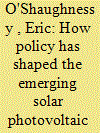

|
|
|
|
|
| Summary/Abstract |
Hundreds of state and local policies support the deployment of residential-scale solar photovoltaic systems in the United States. Policy differences across jurisdictions may explain differences in local photovoltaic industries, such as the number of competing installers, the distribution of market shares among those installers, and the market shares of large national-scale installers in local markets. This paper explores this hypothesis through a novel econometric model, the results of which suggest that various state and local policies indeed shape emerging photovoltaic industries. The results suggest that policies that generate higher customer electricity cost savings yield markets with more installers while higher levels of up-front photovoltaic subsidies produce markets with fewer installers. Further, both up-front subsidies and ongoing incentives yield markets where national-scale installers hold less market share. These results indicate that policies have long-term indirect impacts on photovoltaic markets by shaping nascent installation industries. Policymakers could use the results to identify and design policies that help raise infant installation industries to maturity.
|
|
|
|
|
|
|
|
|
|
|
|
|
|
|
|
| 13 |
ID:
192622


|
|
|
|
|
| Summary/Abstract |
China's west has long been framed as an undeveloped frontier, set apart by poverty and a resource-based economy. Since the 2000s, however, utility-scale renewable energy infrastructure has expanded rapidly in western China, promising local economic benefits tied to national low-carbon transition. This paper contends that these benefits have been precarious and unevenly distributed. I argue that utility-scale renewable energy has remade western China as a “low-carbon frontier,” a resource-rich region that generates low-carbon value for the national green economy. I highlight three features of low-carbon frontiers: they are constructed as spaces of exploitable low-carbon resources, creating an investment boom; they are enclosed through new land arrangements and infrastructure construction, rapidly and with little coordination; and they are reliant on external markets and policy decisions, entrenching dependency. These conditions make it difficult for frontier regions to capture sustained economic development benefits from the boom in the absence of persistent central state supports. I analyse these features by comparing two sets of technologies with similar, but ultimately diverging, trajectories: small and large hydropower in China's south-west, and solar and wind in the north-west.
|
|
|
|
|
|
|
|
|
|
|
|
|
|
|
|
| 14 |
ID:
101498
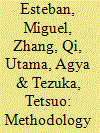

|
|
|
|
|
| Publication |
2010.
|
| Summary/Abstract |
The potentially damaging effects of climate change make it imperative to develop zero-carbon energy systems and societies based on renewable energy sources that do not negatively affect the environment. However, these systems are often criticized for their intermittency, and the present paper proposes a method to analyze the true minimum capacity factor that can be expected from such a system based on a historical hourly estimation of the electricity produced by a given solar-wind generating mix. A simulation was carried out to show how much energy could be produced for a sample future group of scenarios encompassing a variety of solar and wind mixes, and the results show that, with a 1:2 mix of solar to wind energy, the system will always operate at least at 10% capacity from 10:00 to 16:00, as calculated using the meteorological conditions of the year 2001. This study also analyzes the land requirements necessary to implement such a solar-wind energy system, highlighting the vast areas that would be necessary to be covered with wind turbines and solar panels if such a system were to supply the majority of the electricity demand in Japan.
|
|
|
|
|
|
|
|
|
|
|
|
|
|
|
|
| 15 |
ID:
101510


|
|
|
|
|
| Publication |
2010.
|
| Summary/Abstract |
In this paper we explore the tradeoffs between thermal storage capacity, cost, and other system parameters in order to examine possible evolutionary pathways for thermal concentrating solar power (CSP) technologies. A representation of CSP performance that is suitable for incorporation into economic modeling tools is developed. We also combined existing data in order to estimate the global solar resource characteristics needed for analysis of CSP technologies. We find that, as the fraction of electricity supplied by CSP technologies grows, the application of thermal CSP technologies might progress from current hybrid plants, to plants with a modest amount of thermal storage, and potentially even to plants with sufficient thermal storage to provide base load generation capacity. The regional and global potential of thermal CSP technologies was then examined using the GCAM long-term integrated assessment model
|
|
|
|
|
|
|
|
|
|
|
|
|
|
|
|
| 16 |
ID:
094286


|
|
|
|
|
| Publication |
2010.
|
| Summary/Abstract |
Lanterns that use light-emitting diodes (LEDs) powered by batteries, which are in turn charged by grid electricity or small solar panels, have emerged as a cost-competitive alternative to kerosene and other fuel-based lighting technologies, offering brighter light for longer duration at equal or lower cost over time. This paper presents lessons learned from the introduction of solar LED lanterns in rural Malawi. We discuss a market-based program using new and existing local commercial structures such as vendors and cooperatives to sell lanterns to village households without subsidy. The paper addresses issues of enterprise development, community interactions, and survey data on lighting use and expenditure patterns before and after LED lantern introduction. Households that purchased a lantern reported high levels of satisfaction with the LED lanterns as well as savings in annual kerosene expenditure comparable to the price of the lantern. These households also reported monthly incomes comparable to the price of the LED lanterns whereas non-adopters surveyed reported monthly incomes about half this level, suggesting a need for financing options to maximize adoption among poorer populations in rural areas. These results suggest that similar market based models of LED lighting technology dissemination have the potential to be replicated and scaled up in other off-grid regions in developing countries. However, viability of local cooperatives and supply chains for lantern products over the medium-to-long term remain to be assessed.
|
|
|
|
|
|
|
|
|
|
|
|
|
|
|
|
| 17 |
ID:
094394


|
|
|
|
|
| Publication |
2010.
|
| Summary/Abstract |
Lanterns that use light-emitting diodes (LEDs) powered by batteries, which are in turn charged by grid electricity or small solar panels, have emerged as a cost-competitive alternative to kerosene and other fuel-based lighting technologies, offering brighter light for longer duration at equal or lower cost over time. This paper presents lessons learned from the introduction of solar LED lanterns in rural Malawi. We discuss a market-based program using new and existing local commercial structures such as vendors and cooperatives to sell lanterns to village households without subsidy. The paper addresses issues of enterprise development, community interactions, and survey data on lighting use and expenditure patterns before and after LED lantern introduction. Households that purchased a lantern reported high levels of satisfaction with the LED lanterns as well as savings in annual kerosene expenditure comparable to the price of the lantern. These households also reported monthly incomes comparable to the price of the LED lanterns whereas non-adopters surveyed reported monthly incomes about half this level, suggesting a need for financing options to maximize adoption among poorer populations in rural areas. These results suggest that similar market based models of LED lighting technology dissemination have the potential to be replicated and scaled up in other off-grid regions in developing countries. However, viability of local cooperatives and supply chains for lantern products over the medium-to-long term remain to be assessed.
|
|
|
|
|
|
|
|
|
|
|
|
|
|
|
|
| 18 |
ID:
110372
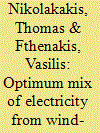

|
|
|
|
|
| Publication |
2011.
|
| Summary/Abstract |
Several countries and states have set targets for substantially increasing renewable energy (RE) contributions in their electricity grids. As the potential for additional hydro-electricity is limited in the US most future RE penetration is envisioned to be in the form of wind and solar. Our simulations, based on hourly resource and load data, demonstrate the maximum penetration achievable in the grid managed by the New York Independent System Operator (NYISO), by wind- and solar-power independently, and when they are combined. By optimizing the synergy between these two intermittent resources, a maximum penetration of renewable-energy in the grid can be accomplished; this is shown for different scenarios of grid flexibility. For example, for an 80% flexible grid, a total penetration of 30% of wind and solar energy can be achieved in the NY state without adding storage and without having to dump more than 3% energy, whereas if this was to be met by wind alone, 12% of energy would have to be dumped. Considering that several US states and countries have high targets for renewable energy penetration, optimizing the mixture of RE to accomplish such goals is valuable for energy managing and planning.
|
|
|
|
|
|
|
|
|
|
|
|
|
|
|
|
| 19 |
ID:
167019
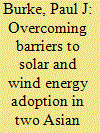

|
|
|
|
|
| Summary/Abstract |
Solar and wind electricity generation technologies have become cost competitive and account for a growing share of global investment in new electricity generation capacity. Both India and Indonesia have ambitious targets for adoption of these technologies, and India has an impressive current rate of uptake. Substantial obstacles exist, however, including the entrenched positions of coal and other fossil fuels, regulatory barriers to market access, and weak abilities of electricity utilities to manage intermittent renewables. This paper reviews these obstacles and discusses strategies to overcome them. We focus on the use of reverse auction processes able to deliver low-price solar and wind contracts, as are being successfully employed in India, on tax and subsidy reform options, on regulatory and incentive-design strategies, on approaches to bolster grid management capacities, and on the importance of minimizing protectionist barriers. Our analysis covers both small-scale and large-scale systems.
|
|
|
|
|
|
|
|
|
|
|
|
|
|
|
|
| 20 |
ID:
176867


|
|
|
|
|
| Summary/Abstract |
Local permitting can ensure the safe installation and operation of rooftop solar photovoltaic (PV) systems. At the same time, burdensome local permitting processes and local variation in requirements may pose challenges to PV deployment. In this article, we explore new data on the durations between key steps in the PV permitting process in the United States. The data suggest that a typical customer can expect to wait around 25–100 days from permit application until an installed system passes inspection. Permit durations vary significantly across jurisdictions, due in part to differences in local permitting policies. However, permit durations vary as significantly within jurisdictions as across them, in part due to significant variation across installers, suggesting that installer strategies and practices play an important role in permitting timelines. Permit durations have declined over time, reflecting progress from permit streamlining policies and jurisdiction learning-by-doing, though durations have stabilized in recent years. The data suggest that typical PV customers still face long and uncertain permitting timelines in the United States.
|
|
|
|
|
|
|
|
|
|
|
|
|
|
|
|
|
|
|
|
|